Cite this document
(“Operant Conditioning, Classical Conditioning and Cognitive learning Essay”, n.d.)
Retrieved from https://studentshare.org/psychology/1425911-operant-conditioning-classical-conditioning-and-cognitive-learning-theories
Retrieved from https://studentshare.org/psychology/1425911-operant-conditioning-classical-conditioning-and-cognitive-learning-theories
(Operant Conditioning, Classical Conditioning and Cognitive Learning Essay)
https://studentshare.org/psychology/1425911-operant-conditioning-classical-conditioning-and-cognitive-learning-theories.
https://studentshare.org/psychology/1425911-operant-conditioning-classical-conditioning-and-cognitive-learning-theories.
“Operant Conditioning, Classical Conditioning and Cognitive Learning Essay”, n.d. https://studentshare.org/psychology/1425911-operant-conditioning-classical-conditioning-and-cognitive-learning-theories.


